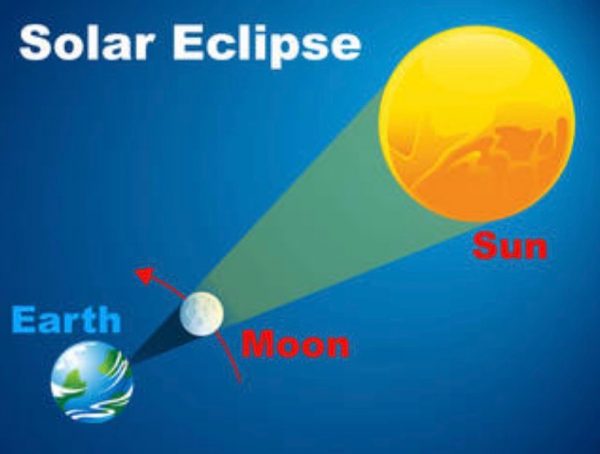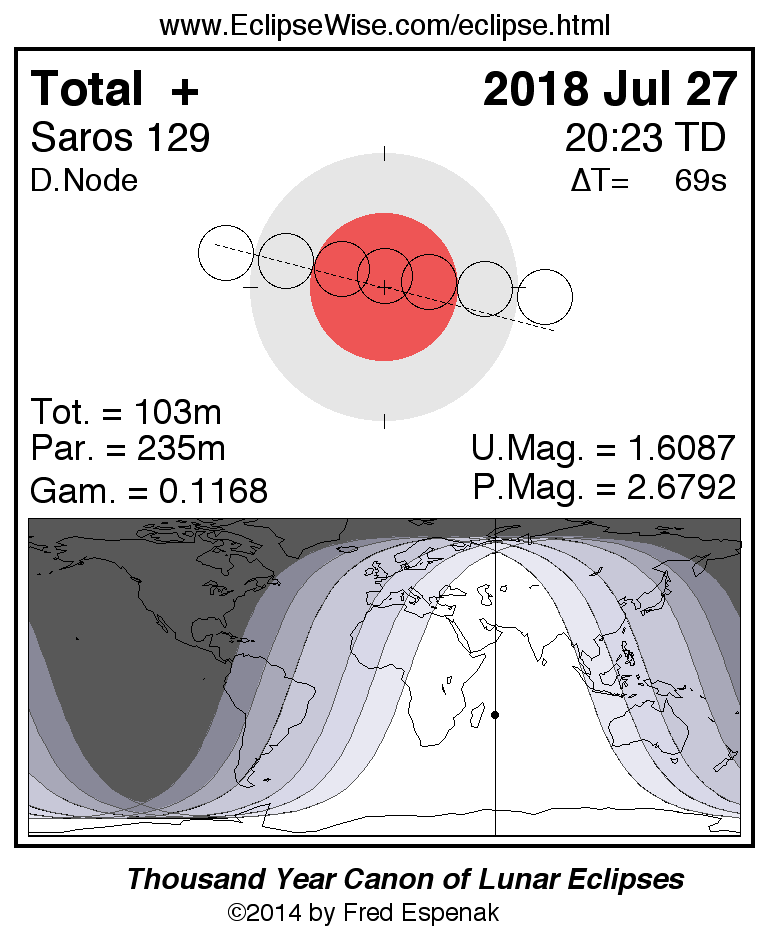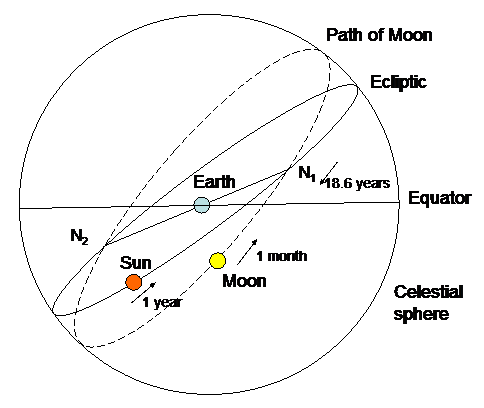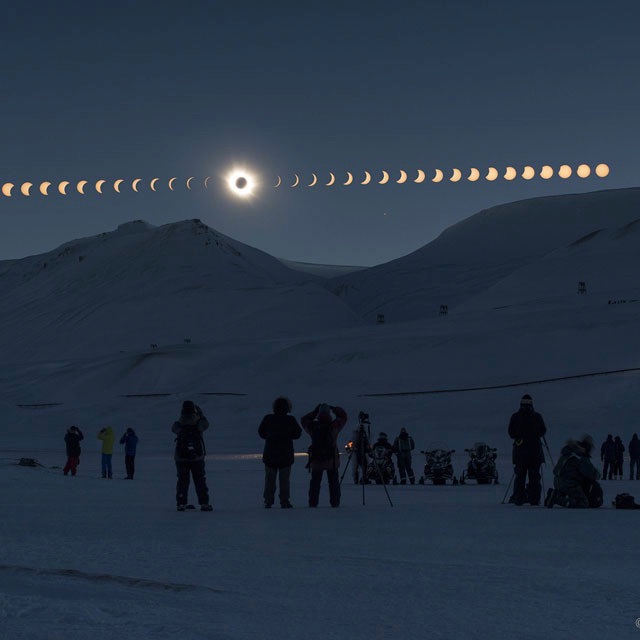Image at top was the Astronomy Picture of the Day for April 20, 2015 – a total solar eclipse over Norway – by Thanakrit Santikunaporn.
On July 28, 2018, we’re smack dab in the middle of an eclipse season. That’s one of two periods during every year when eclipses can and do occur, because the moon crosses the ecliptic (Earth’s orbital plane) around the time of new and full moon.
Eclipses are all about alignments. It’s either the sun, Earth and full moon aligned (Earth in the middle) causing a lunar eclipse. Or it’s the sun, new moon and Earth aligned (moon in the middle), causing a solar eclipse. Eclipse seasons recur in periods of about 173 days (somewhat less than six calendar months), enabling these three bodies to align closely enough in space for two to three eclipses to occur. We had a partial solar eclipse on July 13, 2018, followed by a total lunar eclipse on July 27, 2018. A second partial solar eclipse will take place on August 11, 2018.
That’ll be a total of 3 eclipses for this lunar month and eclipse season.
An eclipse season lasts somewhere around 34 to 38 days, and any full moon or new moon occurring within this period will undergo an eclipse. Then we have another eclipse season some six months later. Thus two full eclipse seasons always occur each year, and we have at least four eclipses (two solar and two lunar) each calendar year. In rare instances, however, it’s possible to have as many as seven eclipses in one year.
Read more: How many eclipses in 1 calendar year?
The middle of the current eclipse season comes on July 28, 2018 at 23 hours Coordinated Universal Time (UTC).


Because a lunar month (time between successive new moons or successive full moons) is approximately 29.5 days long, it’s inevitable that at least one solar and one lunar eclipse should fall within the confines of any eclipse season.
In about 1 out of 7 eclipse seasons, the first eclipse of the eclipse season comes early enough to allow for a total of 3 eclipses in one lunar month. That’s exactly what happens during the present eclipse season.
The next time that 3 eclipses will happen in one eclipse season will be 2020. The annular solar eclipse of June 21, 2020 – which occurs near the midpoint of this eclipse season – will be flanked by a penumbral lunar eclipse on June 5 and again on July 5, 2020. Penumbral lunar eclipses are so faint that people often don’t notice them even while they’re taking place.
Any eclipse near the midpoint of the eclipse season, whether it’s lunar or solar, presents a central eclipse. If it’s a lunar eclipse, it’s a total eclipse of the moon; and if it’s a solar eclipse, it’s either a total or annular eclipse of the sun.
Because the full moon on July 27, 2018, happened near the midpoint of the eclipse season, it staged a total lunar eclipse. Moreover, this full moon closely coincided with apogee – the moon’s farthest point from Earth in its orbit. All added up, that meant a particularly long-lasting total lunar eclipse.
Read more: Century’s longest total lunar eclipse July 27
On the other hand, any eclipse – whether it be solar or lunar – that happens near the beginning or the ending of an eclipse season presents a skimpy eclipse at best. If solar, it’ll be a partial eclipse of the sun; if lunar, it’ll be a partial or penumbral eclipse of the moon.

Now let’s talk briefly about orbital nodes. To understand what a node is, it helps to think in 3D terms. The Earth’s yearly path around the sun defines the Earth’s orbital plane (aka the ecliptic), whereby the moon’s monthly path around Earth defines the plane of the moon’s orbit. The moon’s orbital plane is inclined by about 5 degrees to Earth’s orbital plane; and the moon crosses the Earth’s orbital plane twice a month at points called nodes (N1 and N2 in the diagram below).

The middle of the eclipse season occurs at the instant that the moon’s line of nodes points directly at the sun. For the current eclipse season, that happens on July 28, 2018, at 23 hours UTC.

The midpoint of an eclipse season (when the moon’s nodes align with the Earth and sun) recurs about every 173.3 days; and the midpoint of one eclipse year (of 2 eclipse seasons) recurs every 346.6 days. But the moon returns to the same phase 6 times in about 177 days and 12 times in about 354 days. So the discordance between the eclipse season and the moon’s phases means a pair of eclipses (not 3 eclipses) during the eclipse seasons in 2019:
One eclipse season later:
January 6, 2019: Partial solar eclipse
January 21, 2019: Total lunar eclipseTwo eclipse seasons (one eclipse year) later:
July 2, 2019: Total solar eclipse
July 16, 2019: Partial lunar eclipse
However, 19 eclipse years (or 38 eclipse seasons) are nearly commensurate with 223 lunar months (223 successive returns to new moon or full moon). This eclipse cycle of 223 lunar months (6585.32 days) is known as the Saros cycle, and depending on the number of intervening leap years, represents a period of about 18 years 11.32 days (4 intervening leap years) or 18 years 10.32 days (5 intervening leap years). Therefore, the eclipses coming some 18 years previously – in July 2000 – and some 18 years later – in July and August 2036 – showcase 3 eclipses with similar geometries to those taking place in July and August 2018.
The year 2000:
July 1, 2000: Partial solar eclipse
July 16, 2000: Total lunar eclipse
July 31, 2000: Partial solar eclipseThe year 2018:
July 13, 2018; Partial solar eclipse
July 27, 2018: Total lunar eclipse
August 11, 2018: Partial solar eclipseThe year 2036:
July 23, 2036: Partial solar eclipse
August 7, 2036: Total lunar eclipse
August 21, 2036: Partial solar eclipse
Bottom line: An eclipse season lasts a little over one month and typically includes 1 solar and 1 lunar eclipse. In 1 out of 7 eclipse seasons, the 1st eclipse comes early enough so that 3 eclipses are possible. That’s the case with the current eclipse season. Watch for a 3rd eclipse in this eclipse season, on August 11, 2018.












